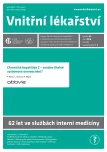Extrahepatic manifestations of HCV infection
Authors:
Petr Husa
Authors‘ workplace:
Klinika infekčních chorob LF MU a FN Brno, pracoviště Bohunice
Published in:
Vnitř Lék 2016; 62(Suppl2): 18-22
Category:
Reviews
Overview
Extrahepatic manifestations of hepatitis C virus infection (HCV) are very common. The most common of these is mixed cryoglobulinaemia. Anti-HCV antibodies and viral ribonucleic acid, HCV RNA, can be found in the cryoprecipitates, together with the rheumatoid factor. Cryoglobulins consist of a complex of immunoglobulins that in vitro precipitate upon the cooling bellow the human body temperature. Vasculitis is caused by the deposition of such immune complexes in the small blood vessels. A link with the HCV infection is considered to be established with membranoproliferative glomerulonephritis, leukocytoclastic vasculitis, lymphoproliferative disorders (in particular B cell lymphoma), Sjögren and sicca syndrome, lichen planus, porfyria cutanea tarda and diabetes mellitus. Very probable is the relationship of chronic HCV infection and thyroid disease, arthralgias, otherwise unexplained fatigue and autoimmune hepatitis.
Key words:
direct acting antivirals – extrahepatic manifestations – chronic hepatitis C – mixed cryoglobulinaemia
Sources
1. Tillmann HL, McHutchison JG. Hepatitis C. In: Boyer TD, Manns MP, Sanyal A. Zakim and Boyer’s Hepatology: A Textbook of Liver Disease. 6th ed. Elsevier Saunders: Philadelphia 2011: 574–576. ISBN 978–1437708813.
2. [European Association for the Study of Liver]. EASL recommendations on treatment of hepatitis C 2014. J Hepatol 2014; 61(2): 373–395.
3. Pascual M, Perrin L, Giostra E et al. Hepatitis C virus in patients with cryoglobulinemia type II. J Infect Dis 1990; 162(2): 569–570.
4. Agnello V, Chung RT, Kaplan LM. A role for hepatitis C virus infection in type II cryoglobulinemia. N Engl J Med 1992; 327(21): 1490–1495.
5. Misiani R, Bellavita P, Fenili D et al. Hepatitis C virus infection in patients with essential mixed cryoglobulinemia. Ann Intern Med 1992; 117(7): 573–577.
6. Pawlotsky JM, Ben Yahia M, Andre C et al. Immunological disorders in C virus chronic active hepatitis: a prospective case-control study. Hepatology 1994; 19(4): 841–848.
7. American Association for the study of Liver Diseases. AASLD recommendation for testing, managing, and treating hepatitis C. Dostupné z WWW:
8. Schott P, Hartmann H, Ramadori G. Hepatitis C virus-associated mixed cryoglobulinemia. Clinical manifestations, histopathological changes, mechanism of cryoprecipitation and options of treatment. Histol Histopathol 2001; 16(4): 1275–1285.
9. Cicardi M, Cesana B, Del Ninno E et al. Prevalence and risk factors for the presence of serum cryoglobulins in patients with chronic hepatitis C. J Viral Hepatol 2000; 7(2): 138–143.
10. Hoofnagle JH, Heller T. Hepatitis C. In: Zakim D, Boyer TD. Hepatology. A Textbook of Liver Disease. 4th ed. Saunders: Philadelphia 2002: 1017–1062. ISBN 978–0721690513.
11. Fraňková S, Urbánek P, Šperl J et al. Diagnostický a terapeutický postup chronické infekce virem hepatitidy C u pacientů s chronickým onemocněním ledvin. Aktuality v nefrologii 2016; 22(2): 63–65.
Labels
Diabetology Endocrinology Internal medicineArticle was published in
Internal Medicine

2016 Issue Suppl2
Most read in this issue
- Late complications of liver cirrhosis – management of gastrointestinal bleeding in the presence of portal hypertension
- Extrahepatic manifestations of HCV infection
- Real data o viral hepatitis C therapy in the Czech Republic
